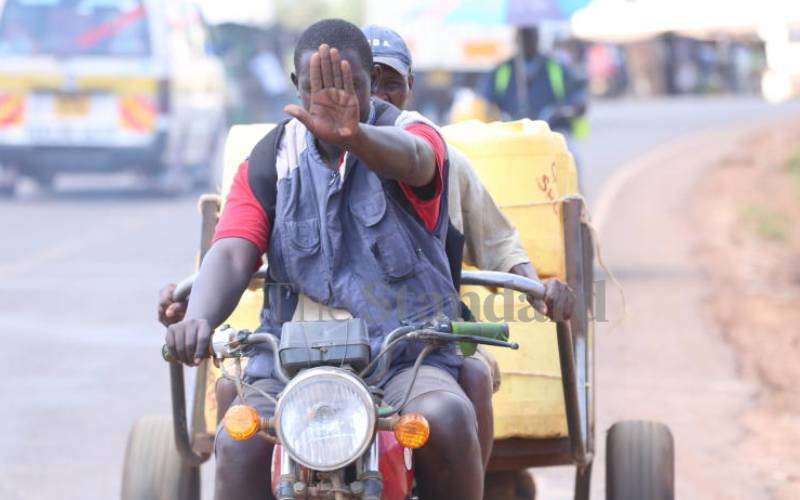 |
|
An ariel view of Nairobi's CBD at night |
BY EMMANUEL WERE
Adding one million people every year piles significant pressure on Kenya’s resources.
There are more mouths to feed, more teachers and schools required and more houses needed to meet the growing demand, especially as Kenya’s urban centres grow.
Consequently, we need more electricity.
But while Kenya’s population has grown at an average of 3.1 per cent every year, electricity consumption has increased at a much slower rate of 1.5 per cent.
For example, in 1980, a Kenyan consumed about 105 kilowatt hours (kWh) per year, enough to light 10 light bulbs of 100 watts each for 105 hours.
Thirty years later, that person consumes just 140 kWh, enough to light 10 bulbs of 100 watts each for about 140 hours.
Yet in those 30 years, the population has more than doubled to 42 million people, meaning that on average a Kenyan should be consuming about 210 kWh of energy per year.
Kenya’s electricity consumption per person is growing at such a slow rate because very little capacity is being added, and electricity remains very expensive.
Coupled with this is the fact that only about 30 per cent of the population has access to electricity — the distribution network is archaic and in urgent need of an upgrade.
Yet with Kenya’s economy growing at an average of five per cent each year, with the dream of doubling the growth rate, there needs to be an increase in power production.
The combination of all these factors leaves the country facing a foreseeable energy crisis if it is to industrialise at the envisioned pace.
“We are injecting megawatts at a slower rate than the rate at which people are being born,” said Simon Ngure, acting CEO of electricity generating company KenGen. “It means people being born now cannot have a better quality of life than their parents,”
Kenya needs to add about 1,000 MW every year for the next 17 years to achieve its Vision 2030 dream of transforming the country into a newly industralising, middle-income economy.
The capacity of electricity required in 2030 will be 33,300 MW — about 15 times more than the 2,300 MW capacity currently installed in the country.
The government has set an ambitious target of adding 5,000 MW of power to the national grid in the next three years.
KenGen, which is listed on the Nairobi Securities Exchange, plans to add about 2,500 MW in the next three years.
“It is not a question of if or whether, but it is a question of we must add this power capacity in the next 40 months to industrialise and grow the economy sustainably,” said Ngure.
Huge demand for power in the country is expected to come from four key areas in the next three years.
There is the iron and steel smelting industry as the country seeks to exploit the mineral resources that have been discovered largely in the coastal and eastern parts of the country.
The iron and steel industry will be an energy guzzler, consuming 2,000 MW annually. This is just about what the whole country needs during the peak hours in the evening when people are at home, watching television, lighting their houses and cooking.
The standard gauge and light rail is yet another planned project that will demand a lot of power, consuming about 1,171 MW.
Kenya and its regional neighbours — Uganda and Rwanda — are pushing to fast track the development of the standard gauge rail line, which will ease the transport of goods and services in the region since it will be cheaper and faster.
Other projects that will need a lot of power include Konza City and other ICT parks as well as county governments, which have big dreams of urbanising.
The Lamu Port Southern Sudan Ethiopia Transport Corridor, more popularly referred to as Lapsset, will have three resort cities and pipelines, and will demand about 350 MW of power when it is completed in 2018.
All these projects are expected to help the country add more jobs and drive the economy to double-digit growth.
Electricity is one of the resources that primarily fuels industrial growth, since many manufacturers and industries depend on it.
“Increasing and growing your GDP means using the resources to sustainably grow wealth,” said Ngure.
To meet this huge energy demand, KenGen has looked at using a mix of sources of energy, including coal, wind, geothermal and gas.
The generating company wants most of the new power added onto the grid to be from the cheaper, renewable forms of energy.
Coal should contribute 960 MW, the bulk of the energy source, given that it is in abundant supply in parts of the country.
Though this will take time, KenGen estimates that, working with a partner, it should start producing electricity from coal in 2017.
Coal is one of the cheapest sources of electricity. It is about 7 per cent cheaper that using gas, and 19 per cent cheaper than nuclear energy, according to statistics from the International Energy Agency (IEA).
However, there is a lot of pressure not to use coal-fired plants because of the effects they have on global warming.
Geothermal generation, therefore, remains one of the best options for KenGen; it produces power at a low cost and is less of a pollutant.
In fact, in KenGen’s three-year plan, geothermal will provide the second-largest contribution to power at 700 MW.
Some of the stations lined up to provide include Olkaria I and IV, which should add about 280 MW to the national grid in the next one year.
But, there is a lot of controversy surrounding the award of tenders when it comes to drilling geothermal energy, with KenGen caught up in a number of cases.
Last week, it emerged that Director of Public Prosecution Keriako Tobiko has called for fresh investigations into the award of a Sh8 billion tender to Great Wall Drilling, a Chinese company, by KenGen in 2006.
The Chinese firm was awarded one of two jobs to drill wells without the tendering process being followed, which drew protests that KenGen flouted procurement laws.
Wind is another source of power KenGen is looking to tap, with the Isiolo wind power project expected to provide 100 MW to the national grid. This project will cost about Sh23 billion to finance.
And that’s where KenGen’s major headache may be: finding financing.
The company needs about Sh467 billion for the projects coming up in the next three years. This amount is a third of Kenya’s Budget for the financial year ending in June 2014.
KenGen said it will issue a mix of debt and equity financing. It hopes to raise about Sh140 billion through joint ventures and the sale of additional shares at the NSE through a rights issue.
Another Sh327 billion will be raised from development partners, commercial banks and possibly through bonds.
KenGen’s debt has been growing over the years, and its long-term loans went up by 24 per cent to Sh97 billion in the year to June 2013.
 The Standard Group Plc is a multi-media organization with investments in media
platforms spanning newspaper print operations, television, radio broadcasting,
digital and online services. The Standard Group is recognized as a leading
multi-media house in Kenya with a key influence in matters of national and
international interest.
The Standard Group Plc is a multi-media organization with investments in media
platforms spanning newspaper print operations, television, radio broadcasting,
digital and online services. The Standard Group is recognized as a leading
multi-media house in Kenya with a key influence in matters of national and
international interest.
 The Standard Group Plc is a multi-media organization with investments in media
platforms spanning newspaper print operations, television, radio broadcasting,
digital and online services. The Standard Group is recognized as a leading
multi-media house in Kenya with a key influence in matters of national and
international interest.
The Standard Group Plc is a multi-media organization with investments in media
platforms spanning newspaper print operations, television, radio broadcasting,
digital and online services. The Standard Group is recognized as a leading
multi-media house in Kenya with a key influence in matters of national and
international interest.










